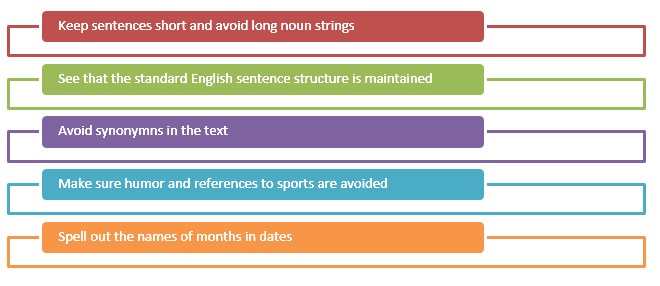Creating Translation-friendly Text for Your Online Course

How can you produce high quality translations of your e-learning course? What does it take to render the content of the course effectively into multiple languages? Well, you need to focus on one of the most important aspects – developing translation friendly textual content for the e-learning course. Here are a few tips.

1. Keep sentences short and avoid long noun strings
Make sure the textual content of your online courses is made up of short sentences, which are not more than 20 words. Short sentences can be translated easily and make reading easy. Also, you need to avoid lengthy noun strings in the textual content of your e-learning course. For instance, instead of using the patent law violation remedy, you can opt for the remedy for the patent law violation. This is important because lengthy text strings complicate the translation of online learning content.
2. See that the standard English sentence structure is maintained
You need to write simple sentences to create translation-friendly textual content for your e-learning course. Construct sentences using the subject-verb-object order without modifiers. For instance, construct sentences such as this course helps service technicians. Avoid sentences such as this free course hugely helps junior service technicians. Adding modifiers could make the sentence complex, thereby complicating the translation.
3. Avoid synonyms in the text
It is better to avoid synonyms in the text of your online course, as they could increase translation costs. For instance, it is better to stick to the word course, rather than use multiple synonyms such as educational program, curriculum, and so on. You need to remember translation costs of your e-learning course are determined by the number of words it contains, and translation memory tools are used to store translated words which help cut costs Most translation memory software leverage words in segments, and altering even one word can have a big impact.
4. Make sure humor and references to sports are avoided
You need to avoid humor in your e-learning course. This is because humor is highly cultural, and what is perceived to be funny in one culture may be considered offensive in others. Similarly, it is advisable not to use references of sports, as the target readers may not be familiar with them. For instance, the term hit wicket can be understood by learners in Australia and other cricket-playing nations, but not by most people in the Francophone world.
5. Spell out the names of months in dates
Dates are written in different formats in different countries. For instance, Americans follow the format month-day-year, while people in many other nations use the format day-month-year. This could give rise to confusion. For example, the date 5-6-2016 is interpreted as 6 May, 2016 in the US, while in other countries, it could mean 5 June, 2016. So, when you translate the text of your e-learning course, it is better to indicate the name of the month in words to prevent misinterpretations. For instance, you could use 6-May-2016 or 5-June-2016.
Developing translation-friendly textual content helps render your online course into multiple languages smoothly. You need to use short sentences in the text of your e-learning course. Ensure the text contains simple sentences and is devoid of synonyms. It is important to avoid humor and references to sports. When you use dates, indicate the month in words.



![5 Benefits of Blended Learning That Will Transform Your Corporate Training [Video]](https://blog.commlabindia.com/hubfs/Imported_Blog_Media/blended-learning-benefits-corporate-training-video.jpg)

![5 Marvelous Tips For Successful E-learning Course Translation [Infographic]](https://blog.commlabindia.com/hubfs/Imported_Blog_Media/tips-for-elearning-course-translations-infographic-2-2.jpg)